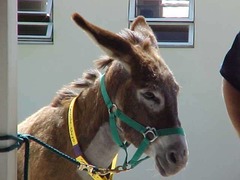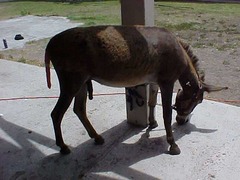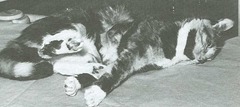RUSVM Anesthesia 2016 for exam 1 – Flashcards
Unlock all answers in this set
Unlock answersquestion
What does general anesthesia include?
answer
Muscle relaxation Narcosis Analgesia
question
Define anesthesia
answer
loss of sensation to the entire part of the body
question
define analgesia
answer
loss of sensitivity to pain
question
define nociception
answer
the neural process of encoding noxious stimuli -doesn't require consciousness
question
define tranquilization
answer
a state of behavioral change, wherein anxiety is relieved ; the pt is relaxed, although aware of its surroundings
question
define sedation
answer
a state characterized by CNS depression accompanied by drowsiness -Pt likely unaware of its surroundings
question
what are the 3 types of sedation?
answer
mild, moderate, profound
question
what level sedation does this represent?

answer
mild
question
what level sedation does this represent?

answer
moderate
question
what level sedation does this represent?

answer
profound
question
define local anesthesia
answer
loss of sensation in a circumscribed body area
question
define regional anesthesia
answer
loss of sensation in a larger, though limited, body area
question
define narcosis
answer
drug induced state of deep sleep from which a pt can't be easily aroused may or may not be accompanied by antinociception
question
define General anesthesia
answer
drug induced UNCONSCIOUSNESS characterized by controlled, reversible depression of the CNS & perception in this state pt is NOT arousable by noxious stimulation Sensory, motor, & autonommic reflex functions are attenduated to varying degrees
question
how is dissociative anesthesia induced? what is it characterized by? what are 2 drugs produce dissociative anesthesia?
answer
induced by drugs that dissociate the thalabocortical & limbic systems characterized by a CATATONIC state where eyes remain open & swallowing reflexes remain functional skeletal muscle rigidity is common unless a muscle relaxing drug is given in conjucntion produced by "dissociative anesthestics" e.g: ketamine & tiletamine (Telazol)
question
what is this picture represent?

answer
catatonic kitty
question
define surgical anesthesia
answer
the stage/plane of general anesthesia that provides unconsciousness, muscle relaxation & analgesia sufficient for painless surgery
question
what is balanced anesthesia
answer
is induced by a multiple rug approach drugs are targeted to attenuate individual components of the anesthetic state: unconsciousness, analgesia, muscle relaxation
question
what are 3 routes of admin of anesthetics
answer
inhalation -anesthetic gases or vapors are inhaled in combination with oxygen injectable -anesthetic solutions are injected intravenously, intramuscularly or subcutaneously oral, transmucosal or intranasal -routes infrequently used with liquids or gels in anesthesia
question
what is flow from O? cylinder to pt?
answer
Cylinder?press. reduct. valve?flowmeter?vaporizer?pt. breathing circuit
question
what is starting volume of O? in E cylinder
answer
660 L
question
what is starting volume of O? in H cylinder
answer
6600 L
question
what is starting pressure of gas in medical cylinders
answer
2200 psi
question
what is the formula to calculate for remaining volume of 0? in cylinder?
answer
660 L/2200 psi = X L/psi remaining in cylinder solve for X
question
what is formula to calculate minutes remaining of O? in cylinder?
answer
X L/ L/min flow
question
what is minimum O?% acceptable for people & SA
answer
30-35% O? (FiO? = 0.30-0.35) minimum
question
what is the metabolic requirement for oxygen What does this # represent?
answer
5-10 mL/kg/min the minimum O? flow!
question
what are the possible adverse pt. effects caused by routine use or mishaps
answer
hypoxia - d/t inadequate O? delivery pneumothorax - d/t ? pressure in lungs (quick flush valve)
question
Advantages of rebreathing system
answer
? fresh gas flow rate req. -pt breathes warm, humidified gases -saves $ -? environ. pollution
question
disadvantages of rebreathing system
answer
? resistance to breathing ?d/t valves ? in anes. gas conc. occur slowly d/t ? fresh gas flow more components? ? potential for leaks
question
types of rebreathing systems
answer
circle universal F -coaxial setup
question
types of non-rebreathing systems
answer
Bain (modified Mapleson D) Mapleson F
question
advantages of non-rebreathing system
answer
light minimal dead space minimal resist. to ventilation ? in anes. gas conc. occur rapidly d/t ? fresh gas flow fewer components? ? potential for leaks
question
when to use non-rebreathing system
answer
small pt < 3kg
question
disadvantages of non-rebreathing system
answer
requires ? gas flow rate pt breathes cold/dry gas ? $ ? environ pollution
question
types of common ET tubes
answer
Murphy-most common type cuffed or uncuffed Cole- common for avian pt uncuffed w/ shoulder Wire reinforced (armored)
question
What has largest effect on resistance to gas flow in ET tube
answer
Radius Poiseuille's Law
question
types of scavenging systems for waste gases
answer
Passive -exhaust directly to atmosphere -F-air canister --absorbs halogenated agents --not N?O Active -piped vacuum
question
what type of absorbent is used with rebreathing system
answer
Soda lime = calcium hydroxide/ sm amt sodium hydroxide ethyl violet color indicator when exhausted



